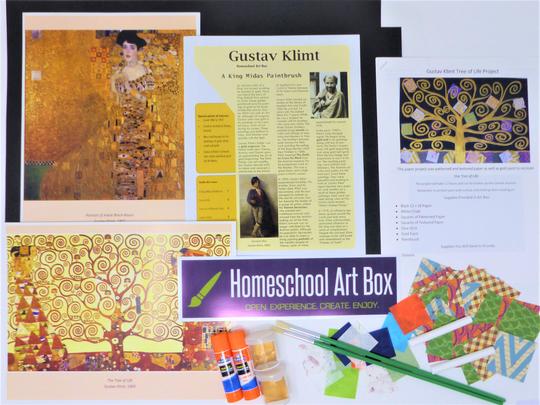The Homeschool Art Boxes provide open-and-go art lessons that include art history, art appreciation, and art projects. With a subscription to Homeschool Art Box, you will receive an art box sent to your home each month that features one artist and an art project related to the artist’s work.
The art boxes are available primarily through subscriptions, and you can select a subscription with project supplies for one, two, or four students. The cost goes up very little for art boxes that add supplies for extra students. So it makes sense to use them with more than one child at a time if possible, both for efficiency and for the fun of creating art projects together.
You can also purchase individual boxes (each good for two students) if you wish, including those from previous years. New boxes are created for each school year, September through May. The publisher intends to create four complete years’ worth of boxes that cover many major artists and important art movements.
Homeschool Art Boxes have already been created for the artists Leonardo da Vinci, Rembrandt van Rijn, Jan van Eyck, Edgar Degas, Jean-Honore Fragonard, Jacques-Louis David, John Trumbull, Mary Cassatt, Charles M. Russell, Winslow Homer, Pablo Picasso, and Gustav Klimt. For the 2021-22 school year, the boxes will feature the artists Michelangelo, Pieter Bruegel the Elder, John Constable, Jean-Francois Millet, Claude Monet, Paul Cezanne, Henri Matisse, Marc Chagall, and Georgia O’Keeffe.
The boxes are intended to be used by students in grades one through eight. Each art box includes a full-color, four-page newsletter about the artist, art movements, the historical period, paintings by that artist, art techniques, and pertinent art terms to learn. The newsletters will probably be most useful with students in third grade and above. Younger children might find much of the content in the newsletters over their heads. With first and second graders, I would share only selected information from the newsletter that I put into simpler language—I would concentrate primarily on the project with them. For children in grades three through five, I would probably read sections from the newsletter aloud and discuss them—but not all of the articles in one day. Because of the level of the vocabulary, I would expect only students in sixth grade and above to read it on their own.
Each art box also includes two 8.5” x 11” prints of artworks featured in the newsletter so that students can study the details more closely as you (or they) read about them. With younger children, you might consider doing picture studies with the art prints, using some of the information in the newsletter to ask questions that will help them notice details and think about what the painting might convey to them.
The most interesting item in the box for most students will be the art project. The projects vary each month in order to introduce students to a variety of art media, such as oil pastels, watercolors, colored pencils, air-dry clay, collage materials, acrylic paints, colored tissue paper, and much more. Things like paintbrushes, glue, and the required paper are included. You only need to supply items such as a pencil, scissors, and smocks for protecting clothing. Step-by-step, illustrated instructions for each project make it easy for students to be successful. The projects are complex enough that they might need to be done in more than one session. The complexity also means that the projects are interesting enough for older students.
For some artists, religious themes are featured in both the newsletters and projects since, for many artists of past centuries, the bulk of their work was religious.
Summary
The Homeschool Art Boxes make it easy to provide well-rounded art education that includes both learning about and creating art.









